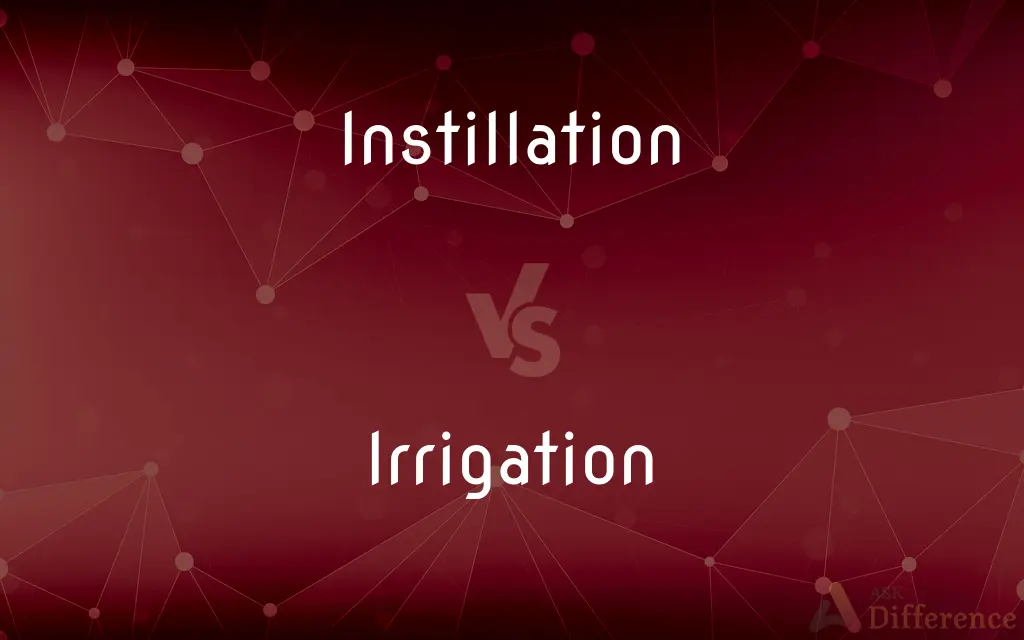Instillation vs. Irrigation — What's the Difference?
By Tayyaba Rehman & Urooj Arif — Updated on March 13, 2024
Instillation involves introducing liquids drop by drop into a body part, often for medication or lubrication, whereas irrigation is the washing or flushing out of a part with water or a medicated solution for cleansing or therapeutic purposes.

Difference Between Instillation and Irrigation
Table of Contents
ADVERTISEMENT
Key Differences
Instillation is a medical procedure that involves carefully administering liquids, such as drugs or saline, drop by drop into a body part, such as the eyes, ears, or nose. This method is precise, focusing on delivering a specific amount of medication or lubricant directly where it's needed. On the other hand, irrigation is a broader technique used to clean or wash out a wound, body cavity, or medical device with a steady flow of water or medicated solution. It aims to remove debris, cleanse, or aid in healing by ensuring the area is clean.
While instillation is typically used for targeted therapy, providing direct treatment or relief to specific areas with controlled dosages, irrigation serves a more general purpose. Irrigation can be used for a variety of reasons, including wound care, dental cleaning, or bladder washouts, relying on the flow of liquid to cleanse or treat an area. Instillation requires precision in the amount of liquid used, often necessitating specialized equipment like droppers or syringes for accurate delivery. Conversely, irrigation may use simpler equipment, such as irrigation syringes, catheters, or even gravity-fed systems, to achieve a thorough washout.
The substances used in instillation often have a therapeutic or lubricating purpose, designed to treat or manage conditions affecting the specific site of application. These substances can include medications, such as antibiotics or corticosteroids, and lubricants. Irrigation, while it can also involve medicated solutions, often utilizes saline or other neutral solutions intended to cleanse rather than treat. The focus is on removing unwanted materials or contaminants to prevent infection or aid in the healing process.
Instillation is a technique that demands careful control and often patient cooperation, especially when applied to sensitive areas like the eyes or ears. It's important for the patient to remain still to ensure the correct dosage is applied. Irrigation, however, might involve more passive participation from the patient, as the process focuses on flushing out an area, which can sometimes be automated or performed without the need for precise patient positioning.
The choice between instillation and irrigation depends on the clinical situation, the part of the body involved, and the desired outcome. While instillation is suited for delivering medication directly to a targeted area, irrigation is preferable for cleaning purposes, especially when dealing with wounds or areas that require flushing out of debris and contaminants.
ADVERTISEMENT
Comparison Chart
Purpose
To administer medication or lubricants drop by drop.
To wash out or cleanse an area with a steady flow of liquid.
Application Area
Eyes, ears, nose, and other specific body parts.
Wounds, body cavities, dental, and medical devices.
Technique
Precise, controlled drops using droppers or syringes.
Steady flow, often using syringes, catheters, or gravity-fed systems.
Substance Used
Medications or lubricants for treatment or lubrication.
Saline, water, or medicated solutions for cleansing.
Patient Role
Requires stillness and cooperation for precise application.
More passive, focusing on the area being cleaned or flushed.
Compare with Definitions
Instillation
The process of administering liquid drop by drop into a body part.
Eye drops are applied through instillation to treat infections.
Irrigation
Often involves simpler equipment compared to instillation.
Irrigation of a surgical site may use a syringe for solution application.
Instillation
A method used to introduce medication directly to an affected area.
Instillation of ear drops can relieve earache.
Irrigation
The procedure of washing out an area with a flow of liquid.
Wound irrigation is essential for preventing infection.
Instillation
Utilizes precise dosing for effective treatment.
Nasal instillation requires specific dosages for congestion relief.
Irrigation
Can be applied to a variety of medical contexts, including wound care and dental hygiene.
Dental irrigation helps remove debris between teeth.
Instillation
Often requires patient cooperation and precision.
Instillation of medication into the bladder necessitates careful administration.
Irrigation
Aims at removing debris, contaminants, or to aid in healing.
Bladder irrigation is performed to prevent urinary tract infections.
Instillation
Can be used for both medication and lubrication purposes.
Lubricating eye drops are instilled to alleviate dry eyes.
Irrigation
Utilizes saline or medicated solutions for cleansing.
Sinus irrigation can help clear nasal passages.
Instillation
To introduce by gradual, persistent efforts; implant
"Morality ... may be instilled into their minds" (Thomas Jefferson).
Irrigation
Irrigation is the artificial process of applying controlled amounts of water to land to assist in production of crops. Irrigation helps to grow agricultural crops, maintain landscapes, and revegetate disturbed soils in dry areas and during periods of less than average rainfall.
Instillation
To pour in (medicine, for example) drop by drop.
Irrigation
To supply (land or crops) with water by means of pipes, sprinklers, ditches, or streams.
Instillation
The act of instilling.
Irrigation
To wash out (a body cavity or wound) with water or a medicated fluid.
Instillation
That which is instilled.
Irrigation
To irrigate land or crops.
Instillation
The act of instilling; also, that which is instilled.
Irrigation
The act or process of irrigating, or the state of being irrigated; especially, the operation of causing water to flow over lands, for nourishing plants.
Instillation
The introduction of a liquid (by pouring or injection) drop by drop
Irrigation
The act or process of irrigating, or the state of being irrigated; especially, the operation of causing water to flow over lands, for nourishing plants.
Instillation
A liquid that is instilled drop by drop
Irrigation
Supplying dry land with water by means of ditches etc
Irrigation
(medicine) cleaning a wound or body organ by flushing or washing out with water or a medicated solution
Common Curiosities
Can instillation be used for any type of medication?
Instillation is primarily used for liquid medications or lubricants that can be precisely administered to specific body areas.
What types of solutions are used in irrigation?
Solutions used in irrigation include saline, water, and sometimes medicated solutions, depending on the purpose of the cleansing.
What are the benefits of instillation over oral medication?
Instillation delivers medication directly to the affected area, offering immediate action and reducing systemic side effects compared to oral medications.
Is specialized equipment required for instillation?
Yes, instillation often requires specialized equipment like droppers or syringes for accurate dosage and application.
How often should irrigation be performed on a wound?
The frequency of wound irrigation depends on the wound's condition, the presence of infection, and healthcare provider recommendations.
How does irrigation help in wound care?
Irrigation helps in wound care by flushing out debris and contaminants, reducing the risk of infection and promoting healing.
Can irrigation be performed at home?
Irrigation, especially for simple procedures like nasal or dental irrigation, can often be performed at home with the right equipment and instructions.
What is the main purpose of instillation in medical treatment?
Instillation aims to administer medications or lubricants directly to a specific part of the body in a controlled manner.
How do patient roles differ between instillation and irrigation procedures?
In instillation, the patient needs to be cooperative and still to ensure precise application, whereas in irrigation, the patient's role can be more passive as the focus is on flushing out an area.
Is instillation suitable for all ages?
Yes, instillation can be adapted for patients of all ages, but it requires careful consideration of the dosage and patient cooperation.
Share Your Discovery

Previous Comparison
Hypersoft vs. Ultrasoft
Next Comparison
Kaftan vs. MuumuuAuthor Spotlight
Written by
Tayyaba RehmanTayyaba Rehman is a distinguished writer, currently serving as a primary contributor to askdifference.com. As a researcher in semantics and etymology, Tayyaba's passion for the complexity of languages and their distinctions has found a perfect home on the platform. Tayyaba delves into the intricacies of language, distinguishing between commonly confused words and phrases, thereby providing clarity for readers worldwide.
Co-written by
Urooj ArifUrooj is a skilled content writer at Ask Difference, known for her exceptional ability to simplify complex topics into engaging and informative content. With a passion for research and a flair for clear, concise writing, she consistently delivers articles that resonate with our diverse audience.
















































